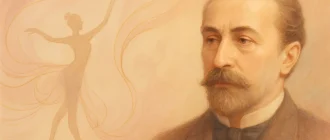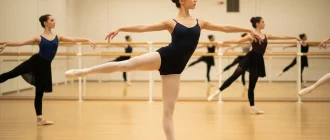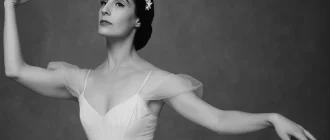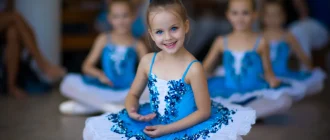The Paquita Ballet is a celebrated classical ballet that premiered in 1846. It tells a story of love and intrigue during Napoleon’s rule in Spain. This article explores its origins, notable characters, and lasting impact on ballet.
Graceful Insights
- Originally premiered in 1846, “Paquita” is a classic romantic ballet that has significantly influenced the repertoire of classical ballet through its intricate choreography and rich narrative.
- The ballet’s story revolves around themes of love and social class during Napoleon’s occupation of Spain. It highlights the protagonist, Paquita, ‘s transformation from a Romani girl to a noble figure.
- Marius Petipa’s revival in the late 19th century and subsequent adaptations by notable choreographers like Rudolf Nureyev and Natalia Makarova have ensured ‘Paquita’s’ continued relevance and popularity in modern ballet.
Art de Podcast
| Feature | Description |
|---|---|
| Title | Paquita |
| Composer | Édouard Deldevez (original score) and Ludwig Minkus (additional music) |
| Choreographers | Joseph Mazilier (original), Marius Petipa (revisions and additions) |
| Premiere Date | April 1, 1846 |
| Premiere Location | Salle Le Peletier, Paris Opera |
| Setting | Spain, during the Napoleonic occupation |
| Main Characters | – Paquita, a young gypsy girl (main heroine) – Lucien d’Hervilly, a French officer and Paquita’s love interest – Iñigo, a gypsy chief |
| Plot Summary | Paquita follows the story of a young girl who discovers she is of noble birth. Initially living with a group of gypsies, she saves and falls in love with Lucien, a French officer, and eventually reunites with her noble family. |
| Signature Pieces | – Pas de Trois – Paquita Grand Pas Classique (usually performed as a stand-alone piece in ballet galas) |
| Style & Influence | Known for its blend of Spanish and classical dance elements, Paquita is heavily influenced by the Romantic ballet style with dramatic storytelling and technical finesse. |
| Notable Revivals | Marius Petipa revived and re-choreographed it in 1881 at the Imperial Ballet (now Mariinsky Ballet), contributing to its lasting popularity. |
| Key Themes | Nobility and birthright, romance, adventure, bravery, and discovery |
| Costuming | Colorful Spanish-inspired costumes with flowing skirts for the female dancers, often featuring ruffles, sashes, and floral adornments. |
| Dance Challenges | Requires high technical skill, strong pointe work for ballerinas, intricate footwork, and coordination in ensemble pieces. |
| Performance Duration | Typically, 1.5 hours for full-length productions; shorter versions include the Grand Pas Classique scene performed as a single-act ballet. |
| Popular Adaptations | Due to the Grand Pas Classique’s technical demands and visual appeal, they are often performed as part of ballet gala events and competitions. |
Paquita Ballet: A Timeless Classic

“Paquita” is a testament to the enduring appeal of romantic ballet. Premiering at the Paris Opera Ballet in 1846, this masterpiece was originally choreographed by the brilliant French composer and ballet master Joseph Mazilier. The ballet’s music, composed by Édouard Deldevez, complements its intricate choreography, creating a harmonious blend of storytelling and dance.
The ballet’s initial run captivated audiences until around 1851, establishing “Paquita” as a significant work within the traditional classical ballet repertory. Although the original version fell out of favor, its revival by Marius Petipa in the late 19th century ensured its place in the rich history of classical ballet.
Today, major ballet companies worldwide continue to perform Paquita, showcasing its timeless charm and the technical brilliance required to bring its characters and story to life.
“Paquita” is celebrated as a timeless classic in the traditional classical ballet repertoire. Its rich narrative and vibrant choreography have played a pivotal role in shaping the standards of classical dancing technique and performance. The ballet continues to captivate audiences, making it a cornerstone of classical dancing.
This article explores the origins and key characters of “Paquita,” examining its significant choreographic elements, notable performances, and modern adaptations that maintain its classic appeal.
From the enchanting story set during Napoleon’s occupation of Spain to the dazzling tutus and intricate set designs, this exploration promises to be both educational and enthralling.
Origins and Synopsis
“Paquita” is a romantic ballet premiered at the Paris Opera Ballet in 1846. Originally choreographed by Joseph Mazilier and featuring music by Édouard Deldevez, it was a significant part of the ballet’s repertory until 1851.
The story, set during Napoleon’s occupation of Spain, unfolds through two acts and three scenes, offering a rich tapestry of love, social class, and intrigue.
The Story of Paquita
The narrative of Paquita is a compelling tale set against the backdrop of Napoleon’s occupation of Spain. At its heart is Paquita, a young Romani girl entangled in a web of intrigue and romance. The story begins with Paquita saving the life of Lucien d’Hervilly, a young French officer, from an assassination attempt orchestrated by the Spanish governor, Don Lopez de Mendoza. This first show of bravery sets the stage for a blossoming romance between Paquita and Lucien despite the obstacles they face.
Paquita discovers her noble birth, revealing her true identity in a dramatic twist that upends her life as a young Romani girl again. The revelation comes through a medallion, which uncovers that Lucien is her cousin, adding a layer of complexity to their relationship. This discovery not only cements Paquita’s place in society but also brings a sense of closure and justice to her past.
The wedding scene in the imperial ballet “Paquita” is a joyous celebration that showcases a variety of traditional dances, reflecting the narrative’s cultural heritage and festive spirit. These dances amplify the celebratory nature of the imperial ballet school andrésthe wedding celebration, highlighting the union of the main characters and the triumph of love over adversity.
The story blends dramatic tension and romantic resolution, making “Paquita” a quintessential romantic ballet. Intricate choreography and vibrant music enhance the storytelling, ensuring a memorable experience for audiences worldwide.
Key Characters
The central characters of “Paquita” drive the ballet’s narrative and emotional depth. Paquita is a very young Romani girl and young gypsy girl who discovers her noble heritage, transforming from an outsider to a celebrated member of society. Her journey is marked by bravery, resilience, and a deep sense of justice, making her a compelling protagonist.
The male lead, Lucien d’Hervilly, is a young French officer who falls in love with Paquita after she saves his life. His character embodies nobility and honor, and his relationship with Paquita underscores the themes of love and social class that permeate the ballet.
Don Lopez de Mendoza, the Spanish governor, is the first act as the antagonist, adding tension and conflict to the story. His desire to eliminate Lucien and Paquita reveals his role in Paquita’s abduction, highlighting the stakes and challenges the characters must overcome.
Historical Context
![]()
The ballet “Paquita” premiered at the Paris Opera in 1846, marking a significant moment in the history of classical ballet. Carlotta Grisi’s performance as Paquita in 1844 was a landmark event, showcasing the ballet’s potential to captivate audiences with its intricate choreography and compelling narrative. Over the years, “Paquita” has undergone several revivals and adaptations, reflecting its enduring popularity and relevance in the ballet world.
Although the original version of “Paquita” fell out of favor, significant parts of Marius Petipa’s 1881 revival remain popular today. The themes of love and social class, set against the backdrop of Napoleon’s rule in Spain, resonate with audiences. The use of historical costume elements and set designs evokes the aesthetics of Spain during the Napoleonic Wars, adding to the ballet’s cultural and historical richness.
Original Choreography
Joseph Mazilier, a renowned French composer and ballet master, originally choreographed Paquita in 1846. The ballet premiered at the Paris Opera Ballet on April 1, 1846, and quickly became a significant part of their repertory until around 1851. Mazilier’s choreography combined dramatic storytelling with the technical demands of classical ballet, creating an artistically challenging and emotionally engaging work.
The original choreography featured vibrant dances and intricate sequences that showcased the dancers’ talents. Although the original full-length ballet is not often performed today, its influence can still be seen in various classical ballets. The dedication to pure dance and the rich narrative structure established in the imperial original full-length ballet by Mazilier laid the groundwork for future revivals and adaptations.
Marius Petipa’s Revival
Legendary Russian ballet master and choreographer Marius Petipa staged “Paquita” in Russia in 1847, marking his first significant work there. Petipa’s 1881 revival of “Paquita” introduced new compositions by Ludwig Minkus, which enhanced the original ballet and significantly contributed to the classical ballet repertoire. This revival included the Grand Pas Classique, a segment that has become one of the major cornerstones of classical ballet.
Petipa’s revival preserved the essence of Mazilier’s choreography while elevating it with innovative additions. The Grand Pas Classique from Petipa’s revival remains a staple in classical ballet, celebrated for its technical mastery and artistic brilliance.
This revival ensured that “Paquita” would remain a part of the traditional classical ballet repertoire for generations.
Paquita Grand Pas Classique

“Paquita” includes several iconic segments, one most celebrated being the Grand Pas de Classique. Introduced in Marius Petipa’s 1881 revival, this segment showcases the technical prowess and artistry expected in classical ballet. A dazzling and glittering showcase of classical technique, the Grand Pas de Classique features variations that highlight the skills of the principal dancers.
Alongside the Grand Pas Classique, segments like the Mazurka des Enfants contribute to Paquita’s rich repertoire and appeal. Ballet companies worldwide perform these segments, ensuring Paquita remains a beloved part of the classical ballet tradition.
Development and Significance
The Grand Pas de Classique has become a staple in classical ballet’s repertoire, performed by companies worldwide. This segment features complex variations showcasing the technical mastery and artistry required in classical ballet. The Grand Pas de Classique is not just a dance but a celebration of the pure dance form, demanding the highest level of skill and precision from the dancers.
Nikita Dolgushin adapted a notable new version of the Grand Pas Classique in 1974, with significant input from former ballerina Elizaveta Gerdt. This adaptation and the original 1881 variations continue to be a cornerstone of classical ballet, highlighting the enduring appeal and technical brilliance of “Paquita.”
Famous Performances
Rudolf Nureyev’s involvement with Paquita is particularly noteworthy. In 1964, he restaged the Grand Pas Classique for the Royal Academy of Dance, bringing renewed attention to this iconic segment. Nureyev’s new version emphasized the technical precision and artistic expression required to perform the Grand Pas Classique, contributing to its continued prominence in ballet.
The American Ballet Theatre has played a significant role in modern performances of “Paquita.” In 1983, Natalia Makarova created a new staging of the Grand Pas Classique for the company, demonstrating its adaptability across different ballet companies and its lasting significance in the traditional classical ballet repertory.
Iconic Dance Pieces
![]()
“Paquita” is renowned for its iconic dance pieces, which have become staples in classical ballet. Pieces like the Mazurka des Enfants and the Paquita Pas de Trois showcase the dancers’ technical and artistic brilliance, contributing to the ballet’s enduring appeal.
Mazurka des Enfants
The Mazurka des Enfants is one of the most vibrant and charming segments. Typically performed in the final and first acts, this piece highlights the playful spirit and youthful energy of the children involved. The lively rhythm and movements serve as a delightful interlude, showcasing young dancers’ skills and adding innocence and joy to the ballet.
The Mazurka des Enfants provides a charming conclusion to the ballet and celebrates the next generation of dancers. Its inclusion reflects the ballet’s blend of technical brilliance and heartfelt storytelling, making it a beloved piece in the classical ballet repertoire.
Paquita Pas de Trois
Another highlight is the Paquita Pas de Trois, which showcases the dancers’ intricate teamwork and individual skill. This segment requires technical precision and strong partnering skills to create a seamless and captivating dance experience.
The American Ballet Theatre first staged Rudolf Nureyev’s version in New York on July 6, 1971, emphasizing its revival and significance in modern ballet. The pas de trois remains crucial to “Paquita’s” choreography, demonstrating this romantic ballet’s enduring appeal and technical demands.
Wedding Scene Dances
The pivotal wedding scene in Paquita showcases celebratory emotions and traditional values. It features various conventional dances, each with its dances and solos, representing different facets of culture and celebration. These dances contribute to the emotional climax and narrative resolution.
Yuri Smekalov’s choreography for the Mariinsky integrates humor and expressive storytelling, showcasing a modern approach to the ballet’s classical roots. The wedding scene highlights the union of the main characters and emphasizes themes of love and unity, making it a memorable and joyous conclusion.
Modern Productions and Revivals
“Paquita” has undergone several revivals and adaptations, particularly by Marius Petipa in the late 19th century, which has ensured its continued relevance. Notable choreographers have restaged the original ballet, bringing their unique vision to this timeless classic.
The American Ballet Theatre has significantly contributed to the modern rendition of “Paquita,” highlighting its enduring appeal. From Natalia Makarova’s 1983 staging to Alexei Ratmansky’s 2014 version for the Bayerisches Staatsballett, “Paquita” continues to evolve while maintaining its core elements.
American Ballet Theatre Version
The American Ballet Theatre has played a pivotal role in keeping “Paquita” alive in modern times. In 1983, Natalia Makarova created a new staging of the Paquita dances for the Grand Pas Classique, showcasing its adaptability across different ballet companies. This latest version highlighted the technical brilliance and artistic beauty of “Paquita,” ensuring its place in the classical ballet repertoire.
Rudolf Nureyev’s staging was first presented at the Royal Academy of Dancing Gala in 1964, further cementing its prominence in ballet. In recent years, choreographers like Alexei Ratmansky and Yuri Smekalov have brought fresh interpretations, demonstrating their timeless appeal and adaptability to contemporary ballet.
Notable Choreographers
Notable choreographers have played significant roles in reviving and preserving “Paquita” for modern audiences. Rudolf Nureyev’s 1964 restaging of the Grand Pas Classique for the Royal Ballet is considered a pivotal work, reinforcing the ballet’s legacy in contemporary performances.
Natalia Makarova’s production premiered at the John F. Kennedy Center for the Performing Arts on December 6, 1983. It showcased her unique vision and contribution to the ballet’s enduring appeal.
These choreographers, among others, have ensured that Paquita remains a vital and beloved part of classical ballet’s repertoire.
Visual History
Historical images of various productions document Paquita’s visual history. These images illustrate the evolution of staging and choreography since the ballet’s 1844 premiere, reflecting its rich legacy and enduring appeal.
Historical Images
Carlotta Grisi’s 1844 performance as Paquita marked one of the earliest celebrated full-length ballet productions. Notable dancers like Ekaterina Vazem and Virginia Zucchi have shaped the iconic characters in “Paquita,” contributing to its classic interpretations. The Pacific Northwest Ballet’s 1998 presentation of Paquita’s grand pas classique showcases imperial ballet and its enduring relevance.
Historical images featuring dancers like Mikhail Fokine and Virginia Zucchi document the rich history and various productions of “Paquita.” They provide a visual journey through the ballet’s evolution, highlighting key moments and performances defining its legacy.
Costumes and Set Design
Costumes for “Paquita” often feature elaborate tutus reflecting Spanish cultural influences, enhancing the visual appeal. With vibrant colors and intricate designs, these costumes contribute to the luxury of the ballet’s themes and historical settings.
Set designs in “Paquita” aim to transport the audience to a visually rich and immersive environment. Modern productions often feature elaborate tutus and intricate sets, ensuring each performance is a glittering showcase of classical ballet’s artistic and technical brilliance.
Resume
“Paquita” remains a timeless classic in ballet, celebrated for its rich narrative, vibrant choreography, and technical brilliance. From its origins at the Paris Opera Ballet to its modern adaptations, “Paquita” continues to captivate audiences with its enduring charm and relevance. The contributions of notable choreographers and the iconic dance pieces ensure that “Paquita” will remain a beloved part of the traditional classical ballet repertoire for generations.
FAQ
What is the structure of the ballet Paquita?
Paquita is a Romantic ballet originally choreographed in two acts and three scenes.
Who composed the original score for Paquita?
The music for Paquita was composed by Édouard Deldevez, with later additions by Ludwig Minkus in 1881.
Who choreographed the first performance of Paquita?
The original choreography was created by Joseph Mazilier for the Paris Opera Ballet in 1846.
When and where did Paquita premiere?
Paquita premiered on April 1, 1846, at the Salle Le Peletier of the Paris Opera Ballet.
What is the setting of Paquita’s story?
The narrative unfolds in early 19th-century Spain during Napoleon’s occupation.
Who are the main characters in Paquita?
The principal roles include Paquita (a young Romani girl of noble birth), Lucien d’Hervilly (a French officer), and the gypsy chief Iñigo.
What is the significance of the Grand Pas Classique in Paquita?
The Grand Pas Classique, added by Marius Petipa in 1881, has become a standalone showcase of classical technique and remains a staple of gala performances.
How did Marius Petipa influence the ballet Paquita?
Petipa mounted the first Russian production in 1847 and, in 1881, revived it with new divertissements by Minkus, cementing its place in the classical repertoire.
Which dance pieces from Paquita are most often performed today?
Today, the Grand Pas Classique, the Pas de trois, and the Children’s Mazurka (“Mazurka des enfants”) survive as concert excerpts.
How has Paquita been preserved for modern audiences?
Petipa’s choreography was notated in the Stepanov method (Sergeyev Collection), and modern reconstructions by Pierre Lacotte (2001) and Alexei Ratmansky (2014) have restored the full two-act ballet to company repertories.
Which major companies regularly stage the Paquita Grand Pas Classique?
Ballet companies, including the Mariinsky, American Ballet Theatre, Paris Opera Ballet, and others, frequently present the Grand Pas Classique as part of their classical programs.
What style of dance does Paquita exemplify?
Paquita is a prime example of 19th-century Romantic classical ballet infused with Spanish-flavored choreography and costuming.
How long does a full-length performance of Paquita last?
A typical full staging runs about two hours and five minutes, including one interval.
What is the historical significance of Paquita in the ballet repertoire?
Paquita represents Marius Petipa’s first major success in Russia, and its 1881 additions helped define the classical variation tradition.
What costume style is typical in Paquita performances?
Performances feature 19th-century Romantic tutus and Spanish-inspired attire, often with colorful skirts, mantilla, and bolero bodices.








